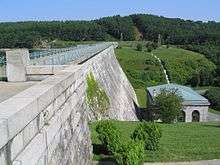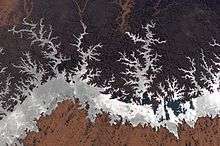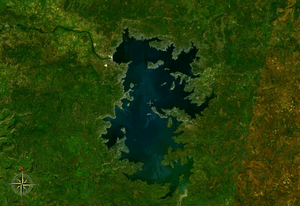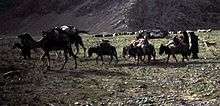Environmental impact of reservoirs

The environmental impact of reservoirs comes under ever increasing scrutiny as the global demand for water and energy increases and the number and size of reservoirs increases.
Dams and reservoirs can be used to supply drinking water, generate hydroelectric power, increase the water supply for irrigation, provide recreational opportunities, and flood control. However, adverse environmental and sociological impacts have been identified during and after many reservoir constructions. Whether reservoir projects are ultimately beneficial or detrimental to either the environment or surrounding human populations has been debated since the 1960s and likely before then, as well. In 1960 the construction of Llyn Celyn and the flooding of Capel Celyn provoked political uproar which continues to this day. More recently, the construction of Three Gorges Dam and other similar projects throughout Asia, Africa and Latin America have generated considerable environmental and political debate.
Upstream impacts

Fragmentation of river ecosystems
A dam also acts as a barrier between the upstream and downstream movement of migratory river animals, such as salmon and trout.[2]
Some communities have also begun the practice of transporting migratory fish upstream to spawn via a barge.[2]
Reservoir sedimentation
Rivers carry sediment down their riverbeds, allowing for the formation of depositional features such as river deltas, alluvial fans, braided rivers, oxbow lakes, levees and coastal shores. The construction of a dam blocks the flow of sediment downstream, leading to downstream erosion of these Sedimentary depositional environments, and increased sediment build-up in the reservoir. While the rate of sedimentation varies for each dam and each river, eventually all reservoirs develop a reduced water-storage capacity due to the exchange of storage space for sediment.[3] Diminished storage capacity results in decreased ability to produce hydroelectric power, reduced availability of water for irrigation, and if left unaddressed, may ultimately result in the expiration of the dam and river.[4]
Impact below dam
Riverline and coastal erosion
As all dams result in reduced sediment load downstream, a dammed river is said to be "hungry" for sediment. Because the rate of deposition of sediment is greatly reduced since there is less to deposit but the rate of erosion remains nearly constant, the water flow erodes the river shores and riverbed, threatening shoreline ecosystems, deepening the riverbed, and narrowing the river over time. This leads to a compromised water table, reduced water levels, homogenization of the river flow and thus reduced ecosystem variability, reduced support for wildlife, and reduced amount of sediment reaching coastal plains and deltas.[4] This prompts coastal erosion, as beaches are unable to replenish what waves erode without the sediment deposition of supporting river systems. Downsteam channel erosion of dammed rivers is related to the morphology of the riverbed, which is different from directly studying the amounts of sedimentation because it is subject to specific long term conditions for each river system. For example, the eroded channel could create a lower water table level in the affected area, impacting bottomland crops such as alfalfa or corn, and resulting in a smaller supply.[5] In the case of the Three Gorges Dam in China the changes described above now appears to have arrived at a new balance of erosion and sedimentation over a 10-year period in the lower reaches of the river. The impacts on the tidal region have also been linked to the upstream effects of the dam.[6]
Water temperature
The water of a deep reservoir in temperate climates typically stratifies with a large volume of cold, oxygen poor water in the hypolimnion. Analysis of temperature profiles from 11 large dams in the Murray Darling Basin (Australia) indicated differences between surface water and bottom water temperatures up to 16.7 degrees Celsius.[7] If this water is released to maintain river flow, it can cause adverse impacts on the downstream ecosystem including fish populations. Under worse case conditions (such as when the reservoir is full or near full), the stored water is strongly stratified and large volumes of water are being released to the downstream river channel via bottom level outlets, depressed temperatures can be detected 250 - 350 kilometres downstream.[8] The operators of Burrendong Dam on the Macquarie River (eastern Australia) are attempting to address thermal suppression by hanging a geotextile curtain around the existing outlet tower to force the selective release of surface water.[9] [10]
Effects beyond the reservoir
Effects on humans
Diseases
Whilst reservoirs are helpful to humans, they can also be harmful as well. One negative effect is that the reservoirs can become breeding grounds for disease vectors. This holds true especially in tropical areas where mosquitoes (which are vectors for malaria) and snails (which are vectors for Schistosomiasis) can take advantage of this slow flowing water.[11]

Resettlement
Dams and the creation of reservoirs also require relocation of potentially large human populations if they are constructed close to residential areas. The record for the largest population relocated belongs to the Three Gorges dam built in China. Its reservoir submerged a large area of land, forcing over a million people to relocate. "Dam related relocation affects society in three ways: an economic disaster, human trauma, and social catastrophe", states Dr. Michael Cernea of the World Bank and Dr. Thayer Scudder, a professor at the California Institute of Technology.[1]
As well, as resettlement of communities, care must also be taken not to irreparably damage sites of historical or cultural value. The Aswan Dam forced the movement of the Temple at Aswan to prevent its destruction by the flooding of the reservoir.
Disaster
Dams occasionally break causing catastrophic damage to communities downstream. Dams break due to engineering errors, attack or natural disaster. The greatest dam break disaster happened in China killing 200,000 Chinese citizens. However, they have happened in California killing 600 people, Germany during World War II and other countries.
Flood Control
The controversial Three Gorges Dam in China is able to store 22 cubic kilometres of floodwaters on the Yangtze River. The 1954 Yangtze River floods killed 33,000 people and displaced 18 million people from their homes. In 1998 a flood killed 4000 people and 180 million people were affected. A flood in August 2009 was completely captured behind the new dam.
Effects on flood-dependent ecology and agriculture
In many developing countries the savanna and forest ecology of the floodplains depend on seasonal flooding from rivers. Also, flood recession cropping is practiced extensively whereby the land is cultivated taking advantage of the residual soil moisture after floods recede. Dams attenuate floods which may affect the ecology and agriculture seriously.

Case studies
- The Manatali reservoir formed by the Manantali dam in Mali intersects the migration routes of nomadic pastoralists and destroyed 43000 ha of savannah, probably leading to overgrazing and soil erosion elsewhere. Further, the reservoir destroyed 120 km² of forest. The depletion of groundwater aquifers, which is caused by the suppression of the seasonal flood cycle, is damaging the forests downstream of the dam.[13]
- After the closure of the Kainji Dam in Nigeria, 50 to 70 percent of the downstream area of flood-recession cropping was lost.[14]
Greenhouse Gases
Reservoirs may contribute to changes in the Earth's climate. Warm climate reservoirs generate methane, a greenhouse gas when the reservoirs are stratified, in which the bottom layers are anoxic (i.e. they lack oxygen), leading to degradation of biomass through anaerobic processes.[15] At a dam in Brazil, where the flooded basin is wide and the biomass volume is high the methane produced results in a pollution potential 3.5 times more than an oil-fired power plant would be.[16] A theoretical study has indicated that globally hydroelectric reservoirs may emit 104 million metric tonnes of methane gas annually.[17] Methane gas is a significant contributor to global climate change.
The following table indicates reservoir emissions in milligrams per square meter per day for different bodies of water. [18]
| Location | Carbon Dioxide | Methane |
|---|---|---|
| Lakes | 700 | 9 |
| Temperate reservoirs | 1500 | 20 |
| Tropical reservoirs | 3000 | 100 |
See also
- Renewable energy debate#Disadvantages of hydroelectricity
- Akosombo Dam#Impacts
- Fish barrier
- Fish ladder
- Environmental impact of irrigation
- Environmental racism
- Environmental racism in Europe
References
- 1 2 A comparative survey of dam-induced resettlement in 50 cases by Thayer Scudder and John Gray
- 1 2 Mann, Charles C; Mark L. Plummer (August 2000). "Can Science Rescue Salmon?". Science, New Series. 289 (5480): 716–719. doi:10.1126/science.289.5480.716.
- ↑ Silenced Rivers: The Ecology and Politics of Large Dams, by Patrick McCully, Zed Books, London, 1996. ISBN 1-85649-902-2
- 1 2 Reservoir Sedimentation Handbook; Morris, Gregory & Fan, Jiahua; McGraw-Hill Publishers; 1998.
- ↑ Sedimentation Engineering; American Society of Civil Engineers Committee; American Society of Civil Engineers Headquarters; 1975.
- ↑ Dai, Zhijun; Liu, James T. (2013-02-14). "Impacts of large dams on downstream fluvial sedimentation: An example of the Three Gorges Dam (TGD) on the Changjiang (Yangtze River)". Journal of Hydrology. 480: 10–18. doi:10.1016/j.jhydrol.2012.12.003.
- ↑ "Review of cold water pollution in the Murray-Darling Basin and the impacts on fish communities". Ecological Management & Restoration. 15: 71–79. doi:10.1111/emr.12074.
- ↑ http://onlinelibrary.wiley.com/doi/10.1111/emr.12074/abstract
- ↑ https://www.statewater.com.au/current+projects/Environmental+projects/Burrendong+temperature+control+structure
- ↑ Hurford, Clive.; Schneider, M; Cowx, Ian; West, Richard (25 June 1997), "21", Conservation Monitoring in Freshwater Habitats, Berlin: Springer Dordrecht, pp. 219–230, doi:10.1007/978-1-4020-9278-7, ISBN 978-1-4020-9277-0, ISSN 0343-6993
- ↑ William R. Jobin, 1999. Dams and Disease: Ecological Design and Health Impacts of Large Dams, Canals, and Irrigation Systems, Taylor & Francis, ISBN 0-419-22360-6
- ↑ ILRI, 1982. Modern interferences in traditional water resources in Baluchistan. In: Annual Report 1982, pp. 23-34. ILRI, Wageningen, The Netherlands. Reprinted in Water International 9 (1984), pp. 106- 111. Elsevier Sequoia, Amsterdam. Also reprinted in Water Research Journal (1983) 139, pp. 53-60. Download from : , under nr. 10, or directly as PDF :
- ↑ A. deGeorges and B.K. Reilly, 2006. Dams and large scale irrigation on the Senegal river: impacts on man and the environment. UNDP Human Development Report. On line: http://hdr.undp.org/en/reports/global/hdr2006/papers/DeGeorges%20Andre.pdf
- ↑ C.A.Drijver and M.Marchand, 1985. Taming the floods. Environmental aspects of the floodplain developments of Africa. Centre of Environmental Studies, University of Leiden, The Netherlands.
- ↑ Climate Change and Dams: An Analysis of the Linkages Between the UNFCCC Legal Regime and Dams.
- ↑ Graham-Rowe, Duncan (2005). "Hydroelectric Power's Dirty Secret Revealed", NewScientist.com.
- ↑ "Methane Emissions from Large Dams as Renewable Energy Resources: A Developing Nation Perspective". Mitigation and Adaptation Strategies for Global Change. 13: 193–206. doi:10.1007/s11027-007-9086-5.
- ↑ https://era.library.ualberta.ca/public/view/item/uuid:29b113ac-6c30-4eaa-9003-89152584f343/DS1/BioSci_50_2000_766.pdf
External links
- Rivers No More: The Environmental Effects of Large Dams at International Rivers (an excerpt for Rivers No More: The Environmental Effects of Large Dams)
- World Commission on Dams
